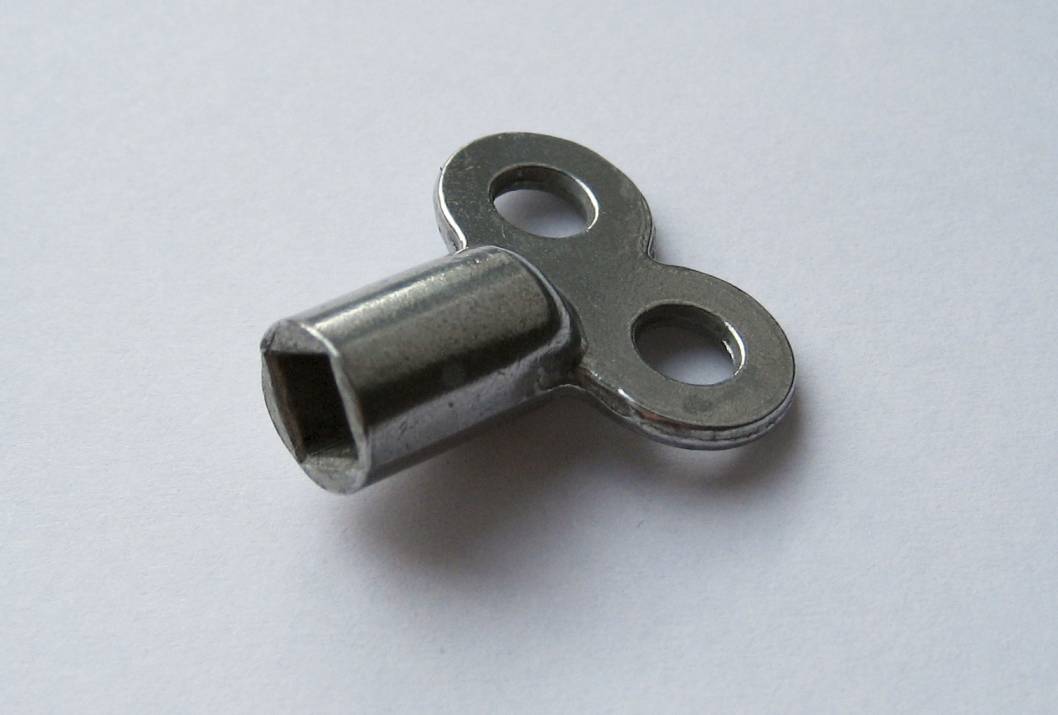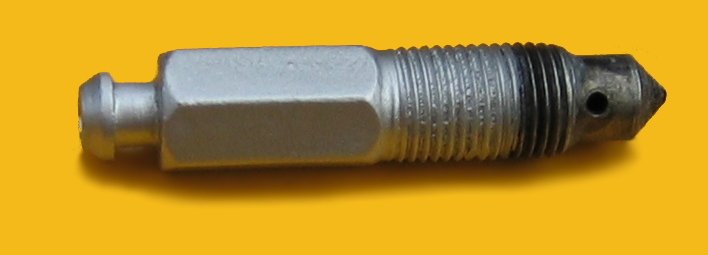Bleed Valve on:
[Wikipedia]
[Google]
[Amazon]
A bleed screw is a device used to create a temporary opening in an otherwise closed hydraulic system, which facilitates the removal of air or another substance from the system by way of pressure and density differences.

 On a home
On a home

Applications
Domestic heating radiators

 On a home
On a home radiator
Radiators are heat exchangers used to transfer thermal energy from one medium to another for the purpose of cooling and heating. The majority of radiators are constructed to function in cars, buildings, and electronics.
A radiator is always a ...
unit, the bleed screw can be opened, usually by means of a key, to allow unwanted air to escape from the unit. Bleed screws are also found on some pump types fulfilling a similar purpose.
They are most often located at the top of the radiator on the side of the inflow pipe. The screw itself, usually a hexagonal or square knob, is inside a small round protrusion.
The key looks similar to that used to wind a clock. It is inserted into the protrusion, mates with the bleed screw and turns it. Opening the bleed screw then allows air which has risen to the top of the radiator system (the top of the radiator itself) to escape and new water to take its place. Removing the air and allowing water to displace it makes the radiator work more efficiently since water conducts heat better than air.
Engine cooling
Engine cooling
Internal combustion engine cooling uses either air or liquid to remove the waste heat from an internal combustion engine. For small or special purpose engines, cooling using air from the atmosphere makes for a lightweight and relatively simple sys ...
systems can also have bleed screws. They can take the form of a bolt with a hole through the middle that is threaded into a hole on the engine's cylinder head
In an internal combustion engine, the cylinder head (often abbreviated to simply "head") sits above the cylinders and forms the roof of the combustion chamber.
In sidevalve engines, the head is a simple sheet of metal; whereas in more modern ov ...
. This hole goes into the water jacket
A water jacket is a water-filled casing surrounding a device, typically a metal sheath having intake and outlet vents to allow water to be pumped through and circulated. The flow of water to an external heating or cooling device allows precise t ...
of the cylinder head
In an internal combustion engine, the cylinder head (often abbreviated to simply "head") sits above the cylinders and forms the roof of the combustion chamber.
In sidevalve engines, the head is a simple sheet of metal; whereas in more modern ov ...
. In other designs, the bleed screw is placed in the uppermost hose which leads to the heater core
A heater core is a radiator-like device used in heating the cabin of a vehicle. Hot coolant from the vehicle's engine is passed through a winding tube of the core, a heat exchanger between coolant and cabin air. Fins attached to the core tubes ser ...
, i.e. at the highest point of the cooling system.
When the bleed screw is loosened, antifreeze
An antifreeze is an additive which lowers the freezing point of a water-based liquid. An antifreeze mixture is used to achieve freezing-point depression for cold environments. Common antifreezes also increase the boiling point of the liquid, all ...
is added to the engine's cooling system and the increase in fluid pressure displaces air through the opened bleed screw. When liquid begins to flow out, all air has been removed from the system and the bleed screw is closed.
Bleed screws are not common on cars today and are only necessary when design of an engine's cooling system results in areas where air can be trapped in the system. Air in the system can lead to overheating of the engine and in modern cars also to poor vehicle operation (e.g. problems with the AC system or incorrect engine idle
Idling refers to running a vehicle's engine when the vehicle is not in motion. This commonly occurs when drivers are stopped at a red light, waiting while parked outside a business or residence, or otherwise stationary with the engine running. Wh ...
).
Hydraulic braking systems
On a hydraulic vehicle braking systems, the bleed screws (sometimes known as ''bleed nipples'' or ''bleeder valves'') are located at the top of eachbrake caliper
A disc brake is a type of brake that uses the calipers to squeeze pairs of pads against a disc or a "rotor" to create friction. This action slows the rotation of a shaft, such as a vehicle axle, either to reduce its rotational speed or to hold ...
to allow bleeding of the braking system. Whenever service work has been performed on the braking system which might have introduced air into the system (i.e. the hydraulic system has been opened), the air must be bled out. This is necessary for correct operation of the system, because air compresses (as opposed to brake fluid
Brake fluid is a type of hydraulic fluid used in hydraulic brake and hydraulic clutch applications in automobiles, motorcycles, light trucks, and some bicycles. It is used to transfer force into pressure, and to amplify braking force. It works be ...
which is not compressible). Air in the system reduces the maximum pressure applied to the brake pistons and can lead to loss of braking ability.

Hydraulic operated clutches
Cars with manualgearshift
A gear stick (rarely spelled ''gearstick''), gear lever (both UK English), gearshift or shifter (both U.S. English), more formally known as a transmission lever, is a metal lever attached to the transmission of an automobile. The term ''gear sti ...
use a clutch
A clutch is a mechanical device that engages and disengages power transmission, especially from a drive shaft to a driven shaft. In the simplest application, clutches connect and disconnect two rotating shafts (drive shafts or line shafts). ...
. Clutches are controlled from pedal by bowden cable
A Bowden cable ( )
is a type of flexible cable used to transmit mechanical force or energy by the movement of an inner cable relative to a hollow outer cable housing. The housing is generally of composite construction, consisting of an inne ...
or hydraulic systems, some use the fluid in common with the brake system. As a dead end of the hydraulic system, the slave cylinder
In automotive engineering, the master cylinder is a control device that converts force (commonly from a driver's foot) into hydraulic pressure. This device controls slave cylinders located at the other end of the hydraulic brake system.
As pi ...
is equipped with a bleed screw.
See also
*Automatic bleeding valve
An automatic bleeding valve or air release valve (ARV) is a plumbing valve used to automatically release trapped air from a heating system.
Air, or other gas, may collect within plumbing. For water delivery systems to taps and basins, particularly ...
* Radiator (heating)
Radiators and convectors are heat exchangers designed to transfer thermal energy from one medium to another for the purpose of space heating.
Denison Olmsted of New Haven, Connecticut, appears to have been the earliest person to use the term ' ...
* Degasification
Degassing, also known as degasification, is the removal of dissolved gases from liquids, especially water or aqueous solutions. There are numerous methods for removing gases from liquids.
Gases are removed for various reasons. Chemists remove gas ...
References
{{Reflist Residential heating Hydraulics Heating, ventilation, and air conditioning Plumbing valves